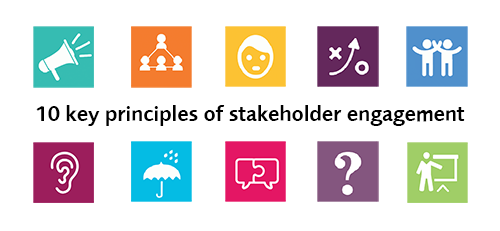10 key principles of stakeholder engagement
Stakeholder engagement and stakeholder management are arguably the most important ingredients for successful project delivery, and yet are often regarded as a fringe activity or one that can be outsourced to business-as-usual functions. Project managers depend on people to respond to the outputs and benefits that they deliver. People will only respond if they are engaged.
The phrase “stakeholder management" implies that these people can be made to respond positively to a project, but the truth is that a project manager frequently has no formal power of authority and therefore has to rely on engagement to achieve his/her objectives.
The '10 Key Principles’ that was developed out of a joint project between the Royal Institute of Chartered Surveyors (RICS) and the Association of Project Management (APM).
1) Communicate
Before aiming to engage and influence stakeholders, it’s crucial to seek to understand the people you will be working with and relying on throughout the phases of the project lifecycle. Sharing information with stakeholders is important, but it is equally important to first gather information about your stakeholders.
Example resources:
- Stakeholder engagement in a globally distributed software project
- Organisational change and stakeholder management
- Stakeholder engagement in an international research and development project
- Stakeholder communication improvements in a software delivery project
- Stakeholder communication improvements in a public infrastructure project
2) Consult, early and often
A project, particularly in the early stages, may be unclear to its stakeholders for example, in terms of purpose, scope, risks and approach. Early, then regular consultation is essential to ensure that requirements are agreed and a delivery solution is negotiated that is acceptable to the majority of stakeholders.
Example resources:
- Stakeholder communication and engagement in a city based transport project
- Stakeholder communication in a school extension project
- Stakeholder communication improvements in the expansion of a university research facility
- Stakeholder communication improvements in a hostel development project
- Stakeholder communication improvements in a IT system delivery project
3) Remember, they’re only human
Accept that humans do not always behave in a rational, reasonable, consistent or predictable way and operate with an awareness of human feelings and potential personal agendas. By understanding the root cause of stakeholder behaviour, you can assess if there is a better way to work together to maintain a productive relationship.
Example resources:
- Stakeholder engagement in a globally distributed software project
- Global teams and stakeholder engagement
- Organisational change and stakeholder management
- Stakeholder communication improvements in a public infrastructure project
- Stakeholder communication in a historic building refurbishment project
- Stakeholder communication and engagement in a city based transport project
- Stakeholder communication improvements in a IT system delivery project
4) Plan it!
A more conscientious and measured approach to stakeholder engagement is essential and therefore encouraged. Investment in careful planning before engaging stakeholders can bring significant benefits.
Example resources:
- Global teams and stakeholder engagement
- Organisational change and stakeholder management
- Stakeholder communication improvements in a public infrastructure project
- Stakeholder communication and engagement in a city based transport project
- Stakeholder communication improvements in the expansion of a university research facility
- Stakeholder communication improvements in a IT system delivery project
- Stakeholder communication within a project team
5) Relationships are key
Developing relationships results in increased trust. And where there is trust, people work together more easily and effectively. Investing effort in identifying and building stakeholder relationships can increase confidence across the project environment, minimise uncertainty, and speed problem solving and decision-making.
Example resources:
6) Simple, but not easy
Over and above conventional planning, using foresight to anticipate hazards, and taking simple and timely actions with stakeholders can significantly improve project delivery. Although this principle is self-evident, in practice is still only rarely done very well.
Example resources:
7) Just part of managing risk
Stakeholders are important influential resources and should be treated as potential sources of risk and opportunity within the project.
Example resources:
- Organisational change and stakeholder management
- Stakeholder engagement in an international research and development project
- Stakeholder communication improvements in a public infrastructure project
- Stakeholder communication improvements in the expansion of a university research facility
- Stakeholder communication within a project team
8) Compromise
The initial step is to establish the most acceptable baseline across a set of stakeholders' diverging expectations and priorities. Assess the relative importance of all stakeholders to establish a weighted hierarchy against the project requirements and agreed by the project Sponsor.
Example resources:
10) Take responsibility
Stakeholder engagement is not the job of one member of the project team. It’s the responsibility of everyone to understand their role and to follow the right approach to communication and engagement. Good project governance requires providing clarity about stakeholder engagement roles and responsibilities and what is expected of people involved in the project.
Example resources:

